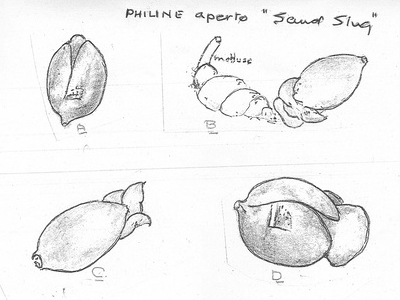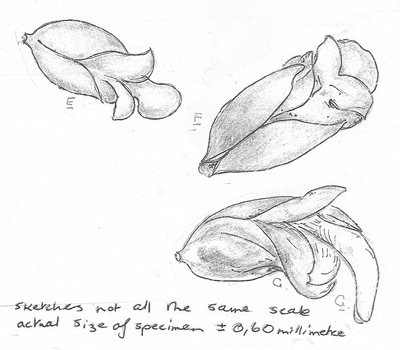Volvatella from east of Cape Town
June 2, 2008
From: Evanne Rothwell


Concerning message #12808:
I work as a volunteer at the Two Oceans Aquarium in Cape town, South Africa. I enclose some drawings of a Philine aperta (?) that was brought in. I would love some further information on it, especially on the purpose of the ?anal end of the animal. In fact, any information would be helpful. The following observations were made: Specimen found in the residues of a recovery dive in False bay. Almost invisible. It's colour is a transparent "Tupperware" with a darker area apparent through the skin. It appears to have an internal "flexible " shell. Shows active movement, flexing, extending, contracting and a colour change from the aforementioned colour to varieties of blue. The sketches A- G made as the animal moved around, ate.
Locality: Cape Town, ?, South Africa, False Bay (Indian Ocean), 27 May 2008, Retrieved from a dive - depth unknown. Length: 0.60 mm. Photographer: Illustrator - Jason Lewis.
Evanne Rothwell
terry@marques.co.za
Dear Evanne,
From the drawings I would say this is a species of Volvatella, and most probably Volvatella laguncula, which is illustrated in Terry Gosliner's book on Sth African opisthobranchs. It was originally named on the basis of two empty shells, but Tom Thompson (1979) studied living animals and reproted that it fed on the 'roots' of the green alga Caulerpa filiformis. Identifying species of Volvatella is a bit difficult ecause we do not really know much about the geographic distribution and shell varaibility of any of the described species, but on existing information, this species seems to be endemic to southern Africa.
The shell is in fact external, but as you describe it is flexible. It is a primitive sacoglossan slug, and like most of that group is a suctorial herbivore, sucking the cell contents from the 'roots' which anchor their food, Caulerpa filiformis, to the substrate. Have a look at other related species on the Forum by using the Species List.
One thing I find a bit puzzling is the size. Do you really mean 0.6 mm? That seems a bit small?
-
Thompson, T. E. (1979) Biology and relationships of the South African sacoglossan mollusc Volvatella laguncula. Journal of Zoology, London 189: 339-347, Figs 1,2a-d.
Best wishes,
Bill Rudman
Related messages
-
Re: Volvatella from east of Cape Town
From: Evanne Rothwell, June 3, 2008
